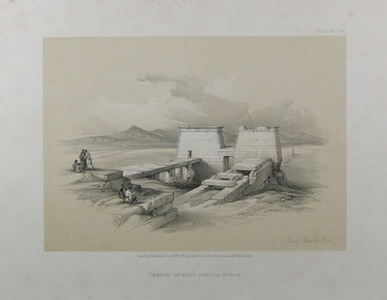| Method | Lithograph with tint stone |
| Artist | after David Roberts |
| Published | London, Published June 16th. 1856, by Day & Son, Gate Street, Lincoln's Inn Fields |
| Dimensions | Image 125 x 176 mm, Sheet 205 x 295 mm |
| Notes |
Plate 168 from Volume 4 of the small format reprint of Roberts' The Holy Land, Syria, Idumea, Arabia, Egypt & Nubia. A view of the temple at Wadi es-Sebua, in the ancient Egyptian region of Nubia. Wadi es-Sebua was the site of two ancient Egyptian temples, one built by Amenhotep III and restored by Ramesses the Great, and a larger temple built by Ramesses himself. The settlement was an important post on the Nubian caravan routes, and one of the residences for the viceroy of Kush. The sites Arabic name means 'Valley of the Lions,' given in reference to the avenue of sphinxes which lined the approach to Ramesses' temple. The temple of Ramesses was moved in the 1960s to preserve it from flooding by the extended Aswan Dam. In Roberts' view, the pylons of the gateway to the temple are shown from the back, looking down on the courtyard in the foreground, most of which is buried in sand. Two statues are partially visible against the courtyard's colonnade. Beyond the pylons, a number of the sphinxes lining the approach to the temple can be seen, as well as one of a pair of standing pharaonic statues. A small group of visitors to the site are gathered on what was once the temple roof, now just above ground level. David Roberts RA (24th October 1796 – 25th November 1864) was a Scottish painter. He is especially known for a prolific series of detailed prints of Egypt and the Near East produced during the 1840s from sketches made during long tours of the region (1838-1840). This work, and his large oil paintings of similar subjects, made him a prominent Orientalist painter. He was elected as a Royal Academician in 1841. The firm of Day & Haghe was one of the most prominent lithographic companies of the nineteenth-century. They were also amongst the foremost pioneers in the evolution of chromolithography. The firm was established in 1823 by William Day, but did not trade under the moniker of Day & Haghe until the arrival of Louis Haghe in 1831. In 1838, Day & Haghe were appointed as Lithographers to the Queen. However, and perhaps owing to the fact that there was never a formal partnership between the two, Haghe left the firm in the 1850's to devote himself to watercolour painting. The firm continued as Day & Son under the guidance of William Day the younger (1823 - 1906) but, as a result of a scandal involving Lajos Kossuth, was forced into liquidation in 1867. Vincent Brookes bought the company in the same year, and would produce the caricatures for Gibson Bowles' Vanity Fair magazine, as well as the illustrations for Cassells's Poultry Book, amongst other commissions. Condition: Light foxing to margins, not affecting image. |
| Framing | unmounted |
| Price | £30.00 |
| Stock ID | 39137 |

